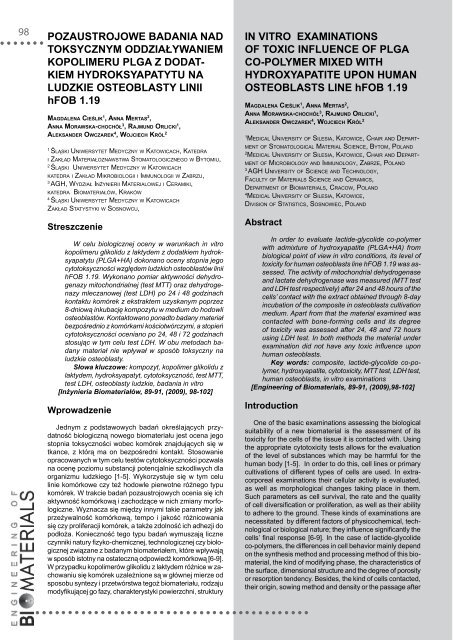89-91 - Polskie Stowarzyszenie Biomateriałów
89-91 - Polskie Stowarzyszenie Biomateriałów
89-91 - Polskie Stowarzyszenie Biomateriałów
You also want an ePaper? Increase the reach of your titles
YUMPU automatically turns print PDFs into web optimized ePapers that Google loves.
98<br />
pozauStrojowe badania nad<br />
tokSyCznym oddziaływaniem<br />
kopolimeru plga z dodatkiem<br />
hydrokSyapatytu na<br />
ludzkie oSteoblaSty linii<br />
hfob 1.19<br />
MaGdaLena cieśLik 1 , anna MerTas 2 ,<br />
anna Morawska-chochół 3 , raJMund orLicki 1 ,<br />
aLeksander owczarek 4 , woJciech króL 2<br />
1<br />
Śląski Uniwersytet Medyczny w katowicach, katedra<br />
i zakład Materiałoznawstwa stoMatologicznego w BytoMiU,<br />
2<br />
Śląski Uniwersytet Medyczny w katowicach<br />
katedra i zakład MikroBiologii i iMMUnologii w zaBrzU,<br />
3 agh, wydział inżynierii Materialowej i ceraMiki,<br />
katedra BioMateriałów, kraków<br />
4<br />
Śląski Uniwersytet Medyczny w katowicach<br />
zakład statystyki w sosnowcU,<br />
Streszczenie<br />
W celu biologicznej oceny w warunkach in vitro<br />
kopolimeru glikolidu z laktydem z dodatkiem hydroksyapatytu<br />
(PLGA+HA) dokonano oceny stopnia jego<br />
cytotoksyczności względem ludzkich osteoblastów linii<br />
hFOB 1.19. Wykonano pomiar aktywności dehydrogenazy<br />
mitochondrialnej (test MTT) oraz dehydrogenazy<br />
mleczanowej (test LDH) po 24 i 48 godzinach<br />
kontaktu komórek z ekstraktem uzyskanym poprzez<br />
8-dniową inkubację kompozytu w medium do hodowli<br />
osteoblastów. Kontaktowano ponadto badany materiał<br />
bezpośrednio z komórkami kościotwórczymi, a stopień<br />
cytotoksyczności oceniano po 24, 48 i 72 godzinach<br />
stosując w tym celu test LDH. W obu metodach badany<br />
materiał nie wpływał w sposób toksyczny na<br />
ludzkie osteoblasty.<br />
Słowa kluczowe: kompozyt, kopolimer glikolidu z<br />
laktydem, hydroksyapatyt, cytotoksyczność, test MTT,<br />
test LDH, osteoblasty ludzkie, badania in vitro<br />
[Inżynieria <strong>Biomateriałów</strong>, <strong>89</strong>-<strong>91</strong>, (2009), 98-102]<br />
wprowadzenie<br />
Jednym z podstawowych badań określających przydatność<br />
biologiczną nowego biomateriału jest ocena jego<br />
stopnia toksyczności wobec komórek znajdujących się w<br />
tkance, z którą ma on bezpośredni kontakt. Stosowanie<br />
opracowanych w tym celu testów cytotoksyczności pozwala<br />
na ocenę poziomu substancji potencjalnie szkodliwych dla<br />
organizmu ludzkiego [1-5]. Wykorzystuje się w tym celu<br />
linie komórkowe czy też hodowle pierwotne różnego typu<br />
komórek. W trakcie badań pozaustrojowych ocenia się ich<br />
aktywność komórkową i zachodzące w nich zmiany morfologiczne.<br />
Wyznacza się między innymi takie parametry jak<br />
przeżywalność komórkową, tempo i jakość różnicowania<br />
się czy proliferacji komórek, a także zdolność ich adhezji do<br />
podłoża. konieczność tego typu badań wymuszają liczne<br />
czynniki natury fizyko-chemicznej, technologicznej czy biologicznej<br />
związane z badanym biomateriałem, które wpływają<br />
w sposób istotny na ostateczną odpowiedź komórkową [6-9].<br />
W przypadku kopolimerów glikolidu z laktydem różnice w zachowaniu<br />
się komórek uzależnione są w głównej mierze od<br />
sposobu syntezy i przetwórstwa tegoż biomateriału, rodzaju<br />
modyfikującej go fazy, charakterystyki powierzchni, struktury<br />
in vitro eXaminationS<br />
of toXiC influenCe of plga<br />
Co-polymer miXed with<br />
hydroXyapatite upon human<br />
oSteoblaStS line hfob 1.19<br />
MaGdaLena cieśLik 1 , anna MerTas 2 ,<br />
anna Morawska-chochół 3 , raJMund orLicki 1 ,<br />
aLeksander owczarek 4 , woJciech króL 2<br />
1Medical University of silesia, katowice, chair and dePart-<br />
Ment of stoMatological Material science, BytoM, Poland<br />
2Medical University of silesia, katowice, chair and dePart-<br />
Ment of MicroBiology and iMMUnology, zaBrze, Poland<br />
3 agh University of science and technology,<br />
facUlty of Materials science and ceraMics,<br />
dePartMent of BioMaterials, cracow, Poland<br />
4Medical University of silesia, katowice,<br />
division of statistics, sosnowiec, Poland<br />
abstract<br />
In order to evaluate lactide-glycolide co-polymer<br />
with admixture of hydroxyapatite (PLGA+HA) from<br />
biological point of view in vitro conditions, its level of<br />
toxicity for human osteoblasts line hFOB 1.19 was assessed.<br />
The activity of mitochondrial dehydrogenase<br />
and lactate dehydrogenase was measured (MTT test<br />
and LDH test respectively) after 24 and 48 hours of the<br />
cells’ contact with the extract obtained through 8-day<br />
incubation of the composite in osteoblasts cultivation<br />
medium. Apart from that the material examined was<br />
contacted with bone-forming cells and its degree<br />
of toxicity was assessed after 24, 48 and 72 hours<br />
using LDH test. In both methods the material under<br />
examination did not have any toxic influence upon<br />
human osteoblasts.<br />
Key words: composite, lactide-glycolide co-polymer,<br />
hydroxyapatite, cytotoxicity, MTT test, LDH test,<br />
human osteoblasts, in vitro examinations<br />
[Engineering of Biomaterials, <strong>89</strong>-<strong>91</strong>, (2009),98-102]<br />
introduction<br />
One of the basic examinations assessing the biological<br />
suitability of a new biomaterial is the assessment of its<br />
toxicity for the cells of the tissue it is contacted with. using<br />
the appropriate cytotoxicity tests allows for the evaluation<br />
of the level of substances which may be harmful for the<br />
human body [1-5]. In order to do this, cell lines or primary<br />
cultivations of different types of cells are used. In extracorporeal<br />
examinations their cellular activity is evaluated,<br />
as well as morphological changes taking place in them.<br />
Such parameters as cell survival, the rate and the quality<br />
of cell diversification or proliferation, as well as their ability<br />
to adhere to the ground. These kinds of examinations are<br />
necessitated by different factors of physicochemical, technological<br />
or biological nature; they influence significantly the<br />
cells’ final response [6-9]. In the case of lactide-glycolide<br />
co-polymers, the differences in cell behavior mainly depend<br />
on the synthesis method and processing method of this biomaterial,<br />
the kind of modifying phase, the characteristics of<br />
the surface, dimensional structure and the degree of porosity<br />
or resorption tendency. Besides, the kind of cells contacted,<br />
their origin, sowing method and density or the passage after













